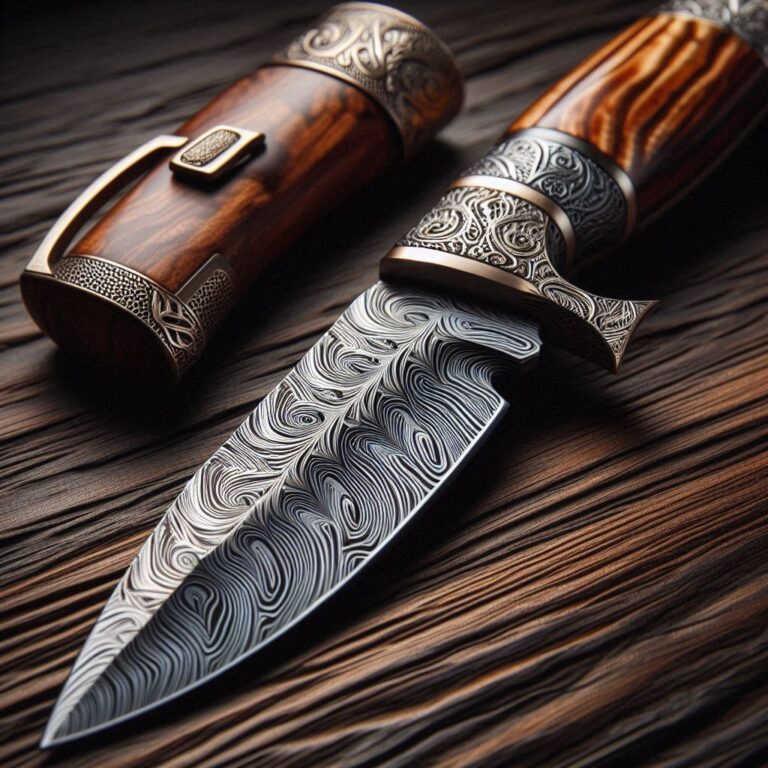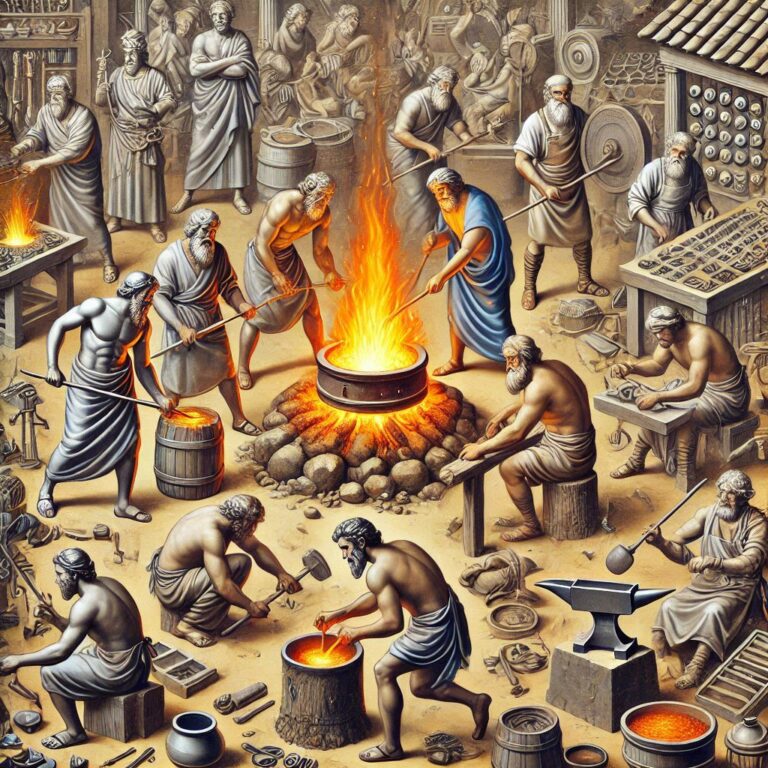Ancient Siege Engines- Roman warfare technology
Siege warfare was the backbone of many military campaigns throughout history, especially for armies facing fortified cities or heavily defended castles. As civilization expanded and fortified cities became the center of political and military power, ancient armies had to develop highly specialized siege engines to conquer these strongholds. From the Greeks and Romans to the Persians, ancient civilizations demonstrated remarkable ingenuity in designing machines that could break through walls, towers, and ramparts. This blog explores the fundamental role of siege engines in warfare, their mechanical principles, and their use across various ancient cultures. Explore how ancient Siege engines, using ballista and catapult, mastered siege warfare with Roman technology and tactical evolution.
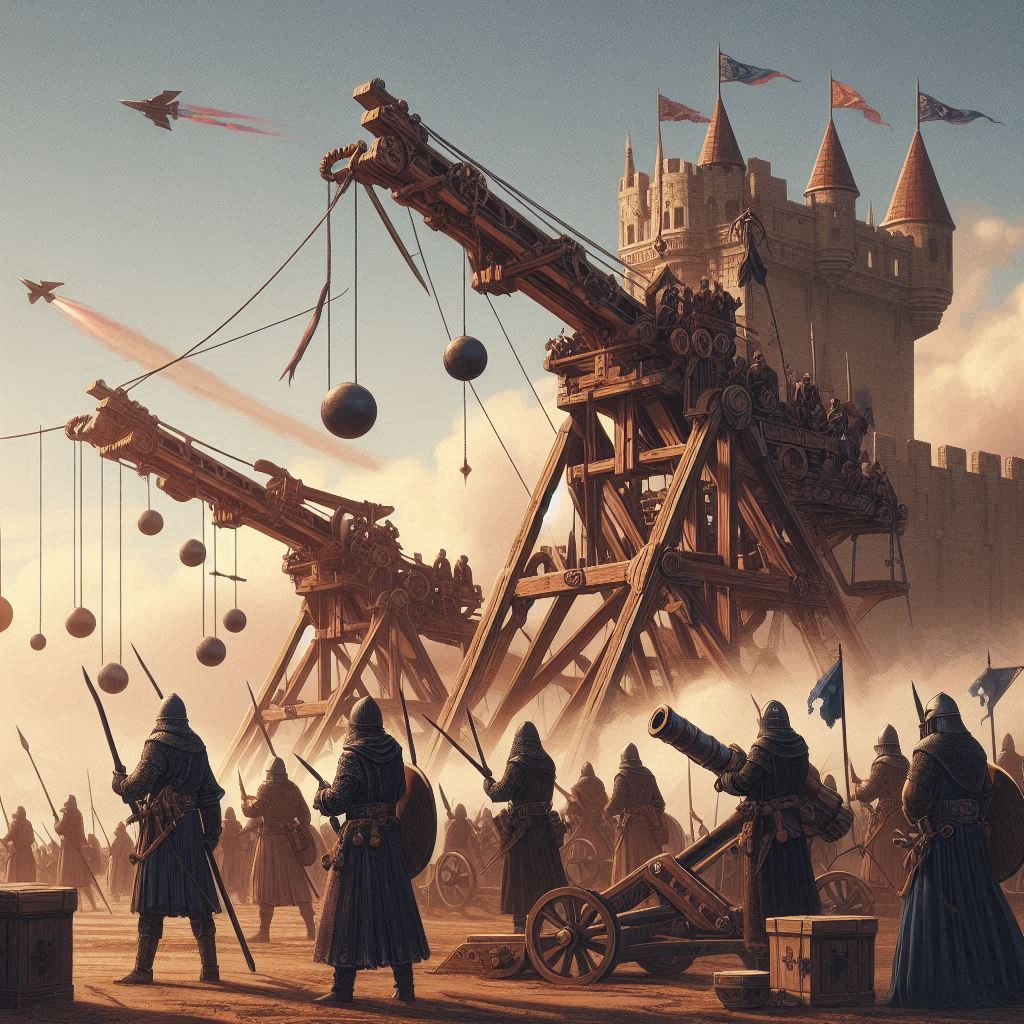
1. The Strategic Power of Siege Engines in Roman Warfare Technologies
Ancient siege engines were not just tools of brute force; they embodied the military engineering genius of their time. Their role in warfare was pivotal in ensuring that fortified cities, castles, and other defensive structures could be neutralized, providing access to the land and resources within. Siege engines often represented the technological edge in warfare, giving attacking armies significant advantages over defenders relying solely on passive fortifications.
Importance of Fortifications
In ancient times, fortresses and walled cities symbolized political and military power. Cities surrounded by towering walls, gates, and defensive structures were considered nearly impregnable. Conquering these cities was often the key to controlling vast territories, as they served as administrative, military, and economic hubs. The strength of a city’s fortifications often dictated how long it could withstand a siege, and many ancient armies understood that direct frontal assaults on these defensive structures could lead to disastrous losses.
Siege engines emerged as the solution to this problem. Instead of sending soldiers to their deaths in attempts to scale walls or storm gates, armies developed machines to do the heavy lifting. Siege engines, such as ballistae, catapults, and battering rams, became indispensable in campaigns where prolonged sieges were necessary. Their ability to break walls, cause psychological damage to defenders, and create openings for infantry assaults changed the dynamics of warfare.
- Psychological Warfare: Siege engines not only damaged physical defenses but also played a psychological role in demoralizing defenders. The constant bombardment from catapults or the sight of an imposing battering ram battering down a gate could weaken the resolve of defenders, leading to surrender.
- Logistical Considerations: Siege engines required careful planning and resource allocation. Their construction and operation involved skilled engineers, materials like wood and metal, and significant manpower. However, their ability to expedite the fall of a city made them worth the investment.
2. Key Siege Engines and Their Construction:
Ancient engineers and military leaders continuously refined siege engines, optimizing them for increased range, power, and accuracy. Below are some of the most important siege weapons developed and deployed in ancient warfare:
Ballista (Ancient Greek and Roman Origins)
The ballista, a large torsion-powered weapon resembling a giant crossbow, was designed for long-range precision. It could launch large bolts or stones with tremendous force, targeting specific points on walls or inflicting heavy casualties among enemy ranks. The Greeks were the first to design the ballista, but the Romans enhanced its mobility, making it an integral part of their military campaigns.
- Construction: The ballista utilized twisted animal sinews to store potential energy. When released, the tension is converted into kinetic energy, propelling projectiles at high speeds. Roman ballistae were versatile; they could be quickly assembled and disassembled, making them suitable for long-distance campaigns. Their design evolved to include both fixed and mobile versions, giving the Romans flexibility in different battlefield scenarios.
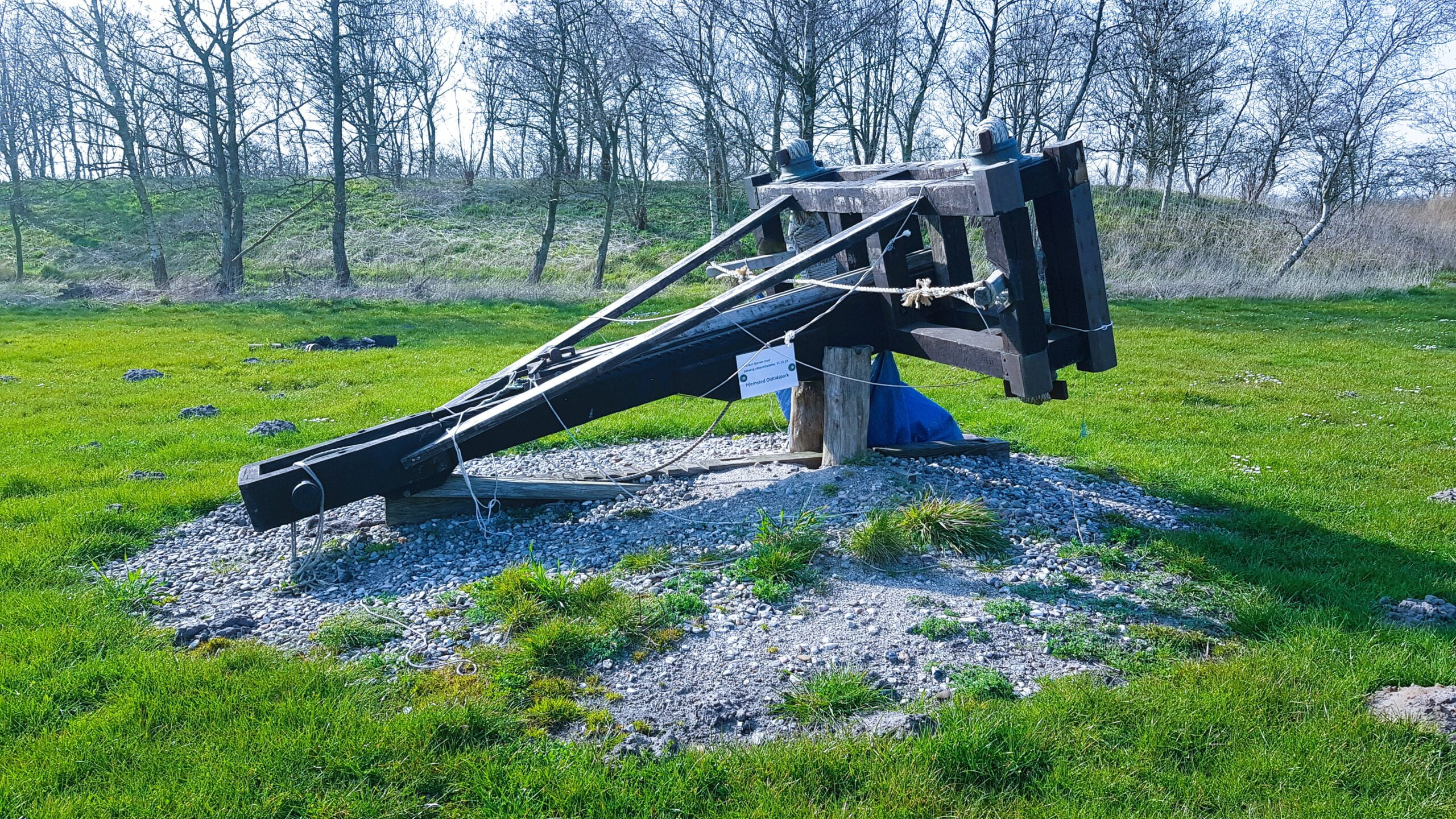
- Tactical Use: Ballistae were often used in sieges to destroy defensive structures or harass enemy troops from a distance. Their precision allowed them to be employed against high-value targets, such as enemy commanders or critical defensive points on walls.
Catapult (Greek and Roman Adaptation)
Catapults functioned as long-range artillery, using a lever arm powered by torsion or tension to hurl large stones, incendiary materials, or other projectiles at enemy defenses. The Greeks initially developed the design, but it was again the Romans who adapted and refined it for widespread use. Unlike the ballista, catapults were used for both direct and indirect fire, allowing armies to target enemy fortifications without needing to get close.
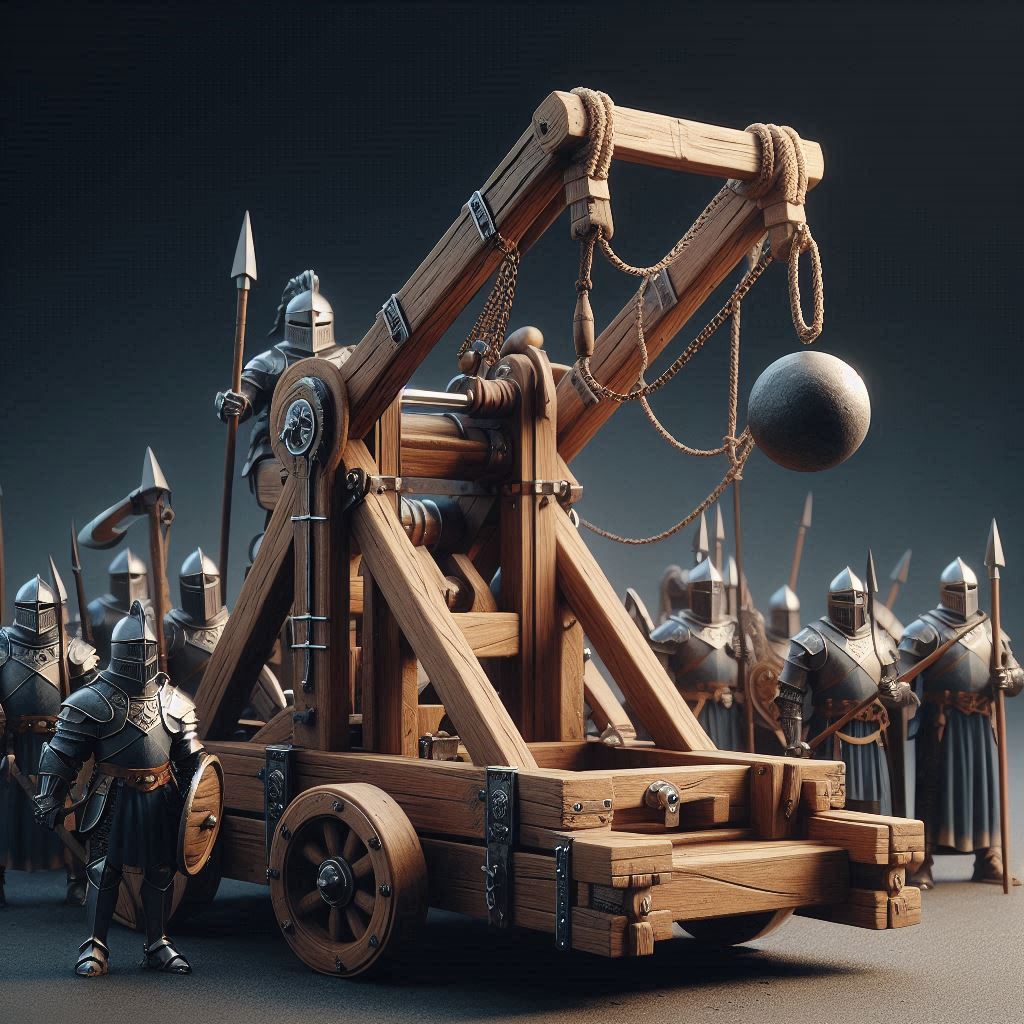
- Strategic Impact: Catapults were used to bombard cities from a safe distance, wearing down fortifications over time. Their ability to launch heavy projectiles demoralized defenders, and their indirect fire capability meant they could hit targets hidden behind walls or towers. Roman military engineers built onagers, a variation of the catapult, which were particularly effective for launching stones.
Ballista vs Catapult: A Comparison of Ancient Siege Power
When it comes to ancient siege warfare, both the ballista and catapult were essential for breaching enemy defenses, yet each had unique strengths. The ballista acted like a giant crossbow, designed for precision and accuracy, perfect for targeting key points in fortifications or enemy troops from long distances. On the other hand, the catapult focused on raw power, launching large projectiles over long ranges to weaken walls and disrupt defensive positions.
The table below highlights the key differences between Ballista vs Catapult:
| Feature | Ballista | Catapult |
|---|---|---|
| Origin | Ancient Greece, later refined by the Romans | Ancient Greece, refined by the Romans (e.g., Onager) |
| Design | Torsion-powered, resembling a giant crossbow | Lever-arm mechanism powered by torsion or tension |
| Projectile Type | Bolts (like giant arrows) or stones | Heavy stones, incendiary materials, or other projectiles |
| Range | Long-range precision fire | Long-range indirect and direct fire |
| Accuracy | Highly accurate, targeting specific points or enemies | Less accurate, meant for area bombardment |
| Tactical Use | Targeting enemy troops, commanders, or weak spots in fortifications | Bombarding walls, fortifications, and demoralizing defenders |
| Portability | More portable, designed for quick assembly and disassembly | Larger and heavier, less mobile |
| Mobility | Flexible, could be moved with armies during campaigns | Stationary during sieges, slower to move and deploy |
| Power | High precision but smaller projectiles | Greater impact with heavier projectiles, causing large-scale damage |
| Best Used For | Selective strikes on weak spots or key individuals | Bombarding enemy walls and fortifications from a distance |
| Development | Roman ballistae became more mobile and refined | Roman catapults (e.g., Onager) launched stones with greater force |
| Construction Materials | Wooden frame, twisted sinew or ropes for torsion power | Wooden frame, tensioned ropes or twisted sinew for launching force |
Trebuchet (Middle Ages but Influenced by Ancient Tech)
Although associated with the Middle Ages, the trebuchet had ancient precursors that influenced its development. The trebuchet’s design incorporated a counterweight mechanism to launch heavier projectiles than the catapult, making it a game-changer in siege warfare.
- Engineering Brilliance: The trebuchet worked by leveraging a large counterweight, which when released, would send the arm and attached sling swinging in an arc. This design enabled it to hurl heavy stones at high trajectories, making it particularly effective against thick and tall fortifications. Unlike torsion-powered devices, trebuchets were more reliable and easier to maintain, as they didn’t require sinew or twisted ropes.

Battering Ram (Ancient Egypt to Rome)
The battering ram was one of the earliest siege engines, dating back to Ancient Egypt. It was a large, heavy beam designed to break through gates and walls. By the time of the Romans, battering rams had evolved significantly, featuring metal-capped heads for added power and protective coverings to shield operators from enemy projectiles.
- Design Evolution: Initially, battering rams were simple logs carried by soldiers. As siege warfare advanced, rams became more sophisticated, incorporating wheeled bases, allowing greater momentum. Protective roofs, often covered in dampened hides, shielded the soldiers operating the ram from burning projectiles or boiling oil poured from above.
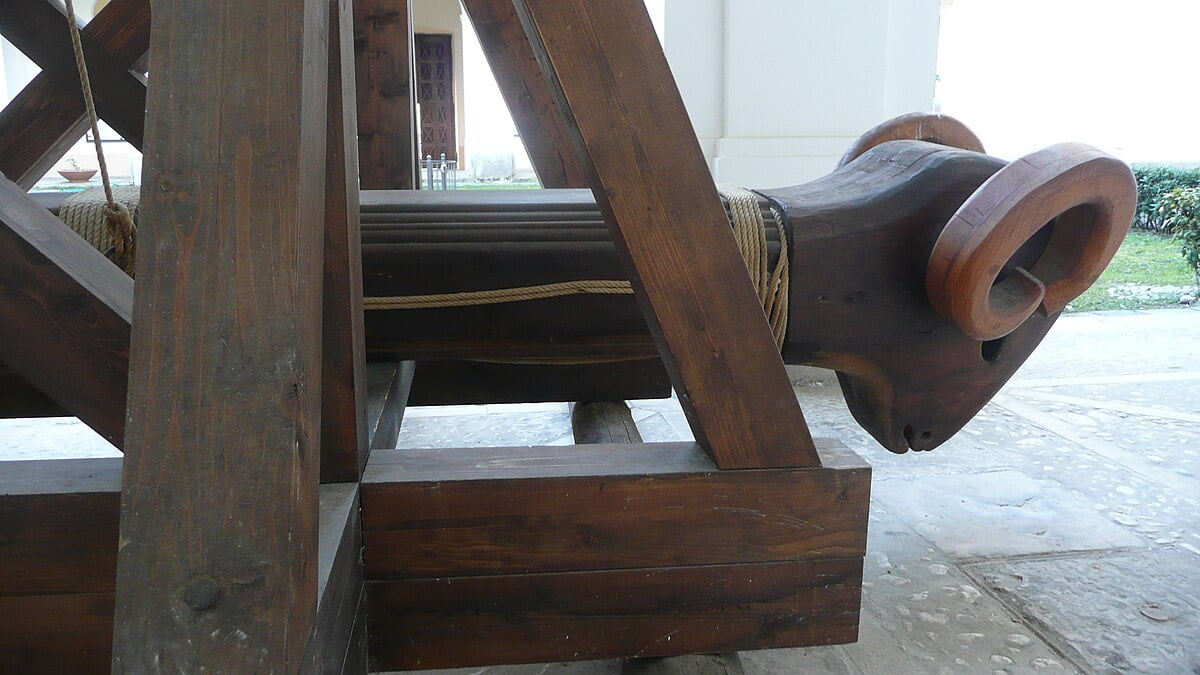
3. Strategic Use of Siege Engines in Historical Battles
Ancient warfare was defined by pivotal sieges where these technologies were deployed to devastating effect. Some of the most famous sieges that highlight the importance of siege engines include:
Siege of Syracuse (214–212 BCE)
During the Second Punic War, the Romans laid siege to the Greek city of Syracuse, defended by the famous mathematician and inventor Archimedes. The Roman forces used siege engines such as catapults and battering rams to try and breach the city’s defenses. However, Archimedes countered with ingenious inventions, including powerful cranes to drop heavy objects onto Roman ships and burning mirrors to set ships ablaze using sunlight.
Siege of Masada (73–74 CE)
The Siege of Masada was a dramatic confrontation between the Roman Empire and Jewish rebels. The fortress, located atop a plateau, was considered impregnable due to its natural defenses. However, the Romans, using a combination of siege ramps, towers, and battering rams, managed to break through after months of preparation. The Jewish defenders chose mass suicide over capture, cementing Masada’s place in history as a symbol of defiance.
Siege of Jerusalem (70 CE)
During the Jewish-Roman War, the Romans, under Titus, laid siege to Jerusalem. Utilizing ballistae, catapults, and battering rams, the Romans systematically weakened the city’s defenses. The siege culminated in the breach of Jerusalem’s walls and the eventual destruction of the Second Temple, a pivotal moment in Jewish history.
These examples illustrate the tactical importance of siege engines and the evolution of ancient military engineering. Siege warfare was a crucial aspect of how empires expanded, secured their territories, and demonstrated their dominance over adversaries.
4. Comparative Study: Greek vs. Roman Siege Technologies
While both the Greeks and Romans made tremendous strides in siege warfare, their approaches were shaped by their respective military strategies, cultural priorities, and engineering prowess. This comparative analysis delves into the distinct innovations and adaptations that marked each civilization’s contributions to siege technology.
Greek Innovations
The Greeks, especially during the time of Alexander the Great, were trailblazers in siege warfare. Greek engineers are credited with the invention of torsion-powered siege engines like the catapult and ballista, which revolutionized warfare by allowing for precise, long-range attacks. These machines used twisted sinew or hair to store energy, which was then released to hurl projectiles at enemy fortifications. Their development was crucial in Alexander’s campaigns, enabling him to conquer highly fortified cities like Tyre and Gaza.
- Siege Towers: Greek engineers also created massive, mobile siege towers called helepoles, which allowed soldiers to scale the walls of enemy cities. These towers were often equipped with ladders, archers, and sometimes even battering rams, providing a platform for direct assaults on enemy fortifications.
- Strategic Focus: Greek siege engines prioritized precision and range, allowing them to weaken defensive positions from a distance. The ballistae, which could accurately shoot large bolts or stones, were particularly favored for their ability to cause significant damage to fortified positions and enemy personnel.
Roman Adaptation
The Romans, with their pragmatic and efficient approach to warfare, built upon Greek designs but added their own innovations to make siege engines more adaptable and portable. Roman engineers focused on making these machines more suited for the rapid pace of Roman military campaigns. This meant ensuring that their siege engines were easy to assemble, disassemble, and transport, allowing them to be deployed quickly in various terrains.
- Portability and Mobility: Roman ballistae and catapults were smaller, more mobile versions of Greek designs. These machines could be set up quickly on battlefields, providing the Romans with a distinct tactical advantage, especially during prolonged sieges where flexibility and speed were key.
- Onager: The Romans introduced the onager, a type of catapult that launched heavy stones at enemy defenses. This machine was more powerful than the Greek catapults and was specifically designed to breach walls, making it highly effective during sieges.
- Siege Towers and Battering Rams: The Romans improved upon Greek siege towers by making them more heavily fortified and adaptable to different battle conditions. They also perfected the battering ram, adding metal-capped heads and protective roofs to ensure that soldiers operating the ram could continue their assault despite enemy fire.
Key Differences
- Weapon Preference: While the Greeks relied heavily on long-range weapons like the ballista for precision strikes, the Romans often employed battering rams and siege towers to conduct direct assaults on fortified positions.
- Adaptability: The Romans prioritized portability and ease of use, ensuring their machines could be transported quickly and deployed in a variety of battle scenarios. Greek siege engines, on the other hand, were typically larger and more stationary, reflecting a different strategic approach to warfare.
5. The Evolution of Siege Technology: From Antiquity to the Middle Ages
With the fall of the Roman Empire, the evolution of Roman warfare technology didn’t stop. In fact, medieval engineers refined ancient designs and introduced new innovations that made siege warfare even more devastating. Building on the knowledge of the Greeks and Romans, medieval engineers perfected machines like the trebuchet, which became the dominant siege weapon of the Middle Ages.
Counterweight Trebuchets
The most significant medieval innovation in siege warfare was the counterweight trebuchet. Unlike torsion-powered machines like the ballista and catapult, the trebuchet used a counterweight system that relied on gravity to propel projectiles. This made it far more efficient and capable of launching heavier stones over greater distances.
- Range and Power: The trebuchet could launch projectiles weighing hundreds of kilograms, such as boulders or even dead animals (for biological warfare), over long distances and with significant accuracy. Its range and power made it an essential tool for medieval sieges, allowing armies to bombard even the most formidable fortifications.
- Efficient Mechanics: The use of gravity rather than torsion meant that the trebuchet was less prone to mechanical failure, making it more reliable during prolonged sieges.
Legacy of Ancient Siege Technology
Although ancient siege engines like the ballista and catapult continued to be used in the Middle Ages, the trebuchet quickly became the dominant siege weapon due to its superior range and destructive power. Nonetheless, the foundational principles of Greek and Roman siege engineering were evident in these medieval machines, showcasing how ancient innovations influenced later military technologies.
Conclusion
Ancient siege engines were much more than tools of destruction—they were feats of engineering brilliance that reshaped the course of warfare. From the Greeks’ precision-focused ballistae to Roman warfare technology’s adaptable siege towers and onagers, these machines allowed ancient armies to conquer even the most fortified cities. The trebuchet and other medieval advancements built upon this ancient knowledge, show how military engineering evolved over centuries. By studying the mechanics, strategic uses, and cultural innovations behind these machines, we gain a deeper understanding of how they enabled the rise and fall of empires throughout history.
Explore our other interesting blogs;


